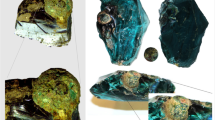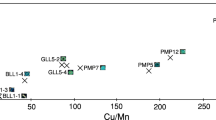Abstract
Roman colored opaque vessel glasses and mosaic tesserae were examined using energy dispersive X-ray analysis, wavelength dispersive X-ray analysis, and scanning electron microscopy in order to identify the origins of the antimony-based glass opacifying agents used in the Roman period. Bindheimite and stibnite were considered as mineralogical sources of antimony, and antimonial litharge was investigated as a metallurgical source of antimony. The refining of antimonial silver ores was discussed as a source for antimonial litharge in the Roman period. The morphologies of the antimonate crystallites, their distributions, and the observed correlations of lead to antimony in the glasses indicated that roasted stibnite was the antimony source for the white and blue opaque glasses and antimonial litharge was the antimony source for the yellow and green opaque glasses. Opaque yellow Roman glasses were found to contain a mixture of clastic, subhedral, and euhedral lead pyroantimonate (Pb2Sb2O7) particles. The euhedral crystallites are a rhombohedral modification of Pb2Sb2O7 that is formed above 900 °C.
Similar content being viewed by others
References
H. P. Rooksby, General Electric Corporation Journal 29 (1), 20–26 (1962).
W. E. S. Turner and H. P. Rooksby, Glastechnische Berichte 32K (VIII), 17–29 (1959).
M. Bimson and I. C. Freestone, The Journal of Glass Studies 25, 55–65 (1983).
J. R. Partington, Origins and Development of Applied Chemistry. (Longmans, Green, and Co., London, 1935) p. 113.
J. Henderson, Oxford Journal of Archaeology 4 (3), 267–291 (1985).
J. Henderson, Jewellery Studies 5, 65–76 (1991).
R. E. Clayton, R. C Scrivener, C. J. Stanley, Proceedings of the Ussher Society 7, 258–262 (1990).
R.P. Edwards Transactions of the Institution of Miningand Metallurgy 85B B83–B90 1976
J. D. Dana and E. S. Dana, The System of Mineralogy. (Wiley and Sons, New York, 1951) vol. 2, p. 1018–1019.
G. Natta and M. Baccaredda, Zeitschrift für Kristallographie 85, 271–294 (1933).
G. Dessau, Societa Geologica Italiana — Bolletino 70, 1–64 (1951).
N. H. Gale, Z. A. Stos-Gale, Annual of the British School of Archaeology 76, 169–224 (1981).
M. P. Charlesworth, Trade Routes and Commerce of the Roman Empire. (Georg Alms Press, London, 1924).
C. Palache. H. Berman, and C. Frondel. Danas's System of Mineralogy. 7th ed., (Wiley and Sons, New York, 1944) vol. 1, 270–274.
G. Dessau, Economic Geology 47, 397–413 (1952).
R. J. Forbes, Metallurgy in Antiquity. (E. J. Brill and Co., Leiden, 1950) p. 262.
J. F. Healey, Mining and Metallurgy in the Greek and Roman World. Aspects of Greek and Roman Life Series, edited by H. H. Scullard, (Thames and Hudson, London, 1978) p. 67.
Pliny, Natural History, translated by H. Rackham, Loeb Classical Library Edition, (Harvard University Press, Cambridge, 1952).
R. J. Forbes, Metallurgy in Antiquity. (E. J. Brill and Co., Leiden, 1950) p. 262–263.
R. F. Tylecote, A History of Metallurgy. (The Metals Society, London, 1976), p. 38.
J. F. Healey, in Science in the Early Roman Empire: Pliny the Elder. His Sources and Influences, edited by R. French and F. Greenaway, (Croon Helm, London, 1986) p. 153.
I.S. Oen, J.C. Fernandez, J.I. Mantica Ecomic Geology 70 1259–1278 1975
P. T. Craddock, I. C. Freestone, N. H. Gale, N. D. Meeks, B. Rothenberg, M. S. Tite, in British Museum Occasional Paper#48, Furnaces and Smelting Technology in Antiquity. edited by P. T. Craddock and M. J. Hughes, (British Museum Research Laboratory, London, 1985), p. 199–214.
R. F. Tylecote, The Prehistory of Metallurgy in the British Isles. (The Institute of Metals, London, 1986) p. 55.
R. Shepherd, Ancient Mining. (Elsevier Applied Science, The Institute of Mining and Metallurgy, London, 1993) p. 269, 187.
M. Fleischer, Economic Geology, 50th Anniversary Issue, 970–1025 (1955).
W. E. Hall and G. K. Czamanske, Economie Geology 67, 350–361 (1972).
O. Amcoff, Neues Jahrbuch für Mineralogie Abhandlungen 6, 247–261 (1976).
S. N. Hoda and L. L. Y. Chang, American Mineralogist 60, 621–633 (1975).
K. C. Bailey, The Elder Pliny's Chapters on Chemical Subjects. (Edward Arnold and Co., London, 1927) p. 211.
N. H. Gale, W. Gentner, G. A. Wagner, in Metallurgy in Numismatics, Royal Numismatic Society Special Publication No.13. edited by D. M. Metcalf and W. A. Oddy, (The Royal Numismatic Society, London, 1980) 1, 3–49.
M. M. Stephens, American Mineralogist 16, 532–549 (1931).
E. Galan Huertos, S. Mirete Mayo, Introduccion a los Minerales de España (Instituto Tecnologico Geominero de España, Madrid, 1994) p. 185.
G. G. Garcia, The Mineralogical Record 27, 275–285 (1996).
R. Lodge, Notes on Assaying and Metallurgical Laboratory Experiments. (Wiley and Sons, New York, 1915), p. 43.
G. Agricola, De Re Metallica. Translated by H. C. Hoover and L. H. Hoover, (Dover Publications, New York, 1950), p. 481.
E. Pernicka, H-G. Bachmann, Presented at the 22nd Symposium on Archaeometry, Bradford, UK, 1982.
R. Newton and S. Davison, Conservation of Glass. Butterworth's Series in Conservation and Museology}, (Butterworths, London, 1989) p. 11 and 57.
A.J. Parker, Ancient Shipwrecks of the Mediterranean and the Roman Provinces, BAR International Series 580. (British Archaeological Reports, London, 1992), p. 45, 316.
M. Verita, R. Basso, M. T. Wypyski, and R. J. Koestier, Archaeometry 36 (2), 241–251 (1994).
V. G. Burchard and W. Rudorff, Z. Anorg. Allg. Chem. 447, 149–152 (1978).
P. Vandiver, C. Swann, D. Cranmer, Materials Issues in Art and Archaeology II, Materials Research Society Symposium Proceedings 85 (Materials Research Society, Pittsburgh, 1991), 609–616.
W. E. S. Turner, Journal of the Society of Glass Technology A, 39T-52T (1956).
S.G.E. Bowman, C. P. Stapleton, and I. C. Freestone, presented at the International Symposium on Archaeometry, Urbana, Illinois, 1996.
Acknowledgement
The authors are grateful to John Hunt of the Cornell University Materials Science Center for his assistance with the SEM-WDS analyses and the scanning electron micrographs. Jennifer Mass thanks the Andrew W. Mellon foundation for financial support during the course of this project. The mosaic tesserae excavated from Antioch were obtained through the generosity of Larry Becker at the Worcester Art Museum. The tesserae from Pompeii were obtained with the assistance of Professore Pietro Giovanni Guzzo and Dottore Antonio ds'Ambrosio of the Soprintendenza Archeologica di Pompei and Sara E. Bon and Rick Jones of the Anglo-American Pompeii Project. The authors are also grateful for the mosaic vessel ware fragments that were made available for study by William Gagen, Patricia Gilkison, and Carlos Picón of the Greek and Roman department of the Metropolitan Museum of Art. Finally, the authors wish to thank James H. Frantz, Pete Dandridge, Lisa Pilosi, and Ellen Howe of the Sherman Fairchild Center for Objects Conservation for contributing helpful discussions and suggestions to this work.
Author information
Authors and Affiliations
Rights and permissions
About this article
Cite this article
Mass, J.L., Stone, R.E. & Wypyski, M.T. An Investigation of the Antimony-Containing Minerals used by the Romans to Prepare Opaque Colored Glasses. MRS Online Proceedings Library 462, 193–204 (1996). https://doi.org/10.1557/PROC-462-193
Published:
Issue Date:
DOI: https://doi.org/10.1557/PROC-462-193




